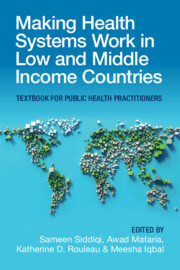 Making Health Systems Work in Low and Middle Income Countries
Making Health Systems Work in Low and Middle Income Countries Health Financing Strategies and Options
from Section 2 - Transforming Health Systems: Confronting Challenges, Seizing Opportunities
Published online by Cambridge University Press: 08 December 2022
The Chapter describes the status of health financing in low- and middle-income countries (L&MICs) and their health financing transition over the past two decades. Advancing Universal Health Coverage (UHC) requires an expansion of coverage over three dimensions: (i) health care benefits, (ii) population coverage, and (iii) cost coverage using prepaid/pooled funds. As national incomes rise, countries undergo a health financing transition, increasing total levels of health expenditure while increasing the publicly financed share of health spending and reducing the external- and OOP-financed share of spending. Two pro-poor paths are common for the expansion of health coverage. Many countries implement health insurance schemes for the poor. Others expand platforms of public providers that are mostly used by the poor, often focusing on community and primary care services. Countries choosing the pro-poor health insurance path develop targeting and enrolment instruments. Targeting tends to be stricter with social security purchasers, compared with ministerial purchasers. Fragmented systems, while suboptimal, can sometimes be more pro-poor than integrated systems.
To save this book to your Kindle, first ensure [email protected] is added to your Approved Personal Document E-mail List under your Personal Document Settings on the Manage Your Content and Devices page of your Amazon account. Then enter the ‘name’ part of your Kindle email address below. Find out more about saving to your Kindle.
Note you can select to save to either the @free.kindle.com or @kindle.com variations. ‘@free.kindle.com’ emails are free but can only be saved to your device when it is connected to wi-fi. ‘@kindle.com’ emails can be delivered even when you are not connected to wi-fi, but note that service fees apply.
Find out more about the Kindle Personal Document Service.
To save content items to your account, please confirm that you agree to abide by our usage policies. If this is the first time you use this feature, you will be asked to authorise Cambridge Core to connect with your account. Find out more about saving content to Dropbox.
To save content items to your account, please confirm that you agree to abide by our usage policies. If this is the first time you use this feature, you will be asked to authorise Cambridge Core to connect with your account. Find out more about saving content to Google Drive.